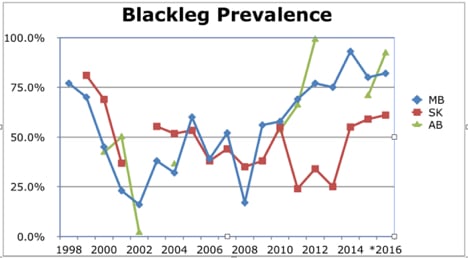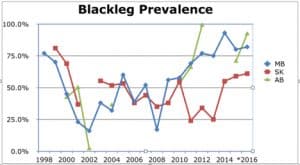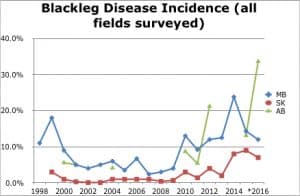Each Prairie province does its own disease survey most years. The Manitoba Canola Disease Survey has been happening for over 15 years and tracks a variety of diseases. Alberta’s survey the past few years has mainly been focused around monitoring the spread of clubroot.
Provincial surveyors typically pick fields at random, assessing 100 plants per field.
Blackleg results are based on prevalence, incidence and severity — but what do these words mean?
Prevalence: This is the percentage of surveyed fields that had plants with blackleg. For example, in the 2015 survey, 80% of Manitoba fields, 59% of Saskatchewan fields and 71% of Alberta fields had blackleg. (See the graph below.)
Incidence: This is the percentage of plants within a field that are infected with the disease. This number can be presented two ways: Average incidence of infected plants across all fields surveyed (including those without blackleg) or incidence in just those fields with blackleg. The percentage of infected plants in only infected fields is typically a few percentage points higher than the percentage of infected plants in all fields surveyed. For example, in Manitoba in 2015, incidence across all fields surveyed was 14% (152 fields total) and incidence for infected fields only was 18% (122 fields). (See the graph below.)
Severity: This uses the blackleg severity scale (0 is no disease, 5 is dead from disease) to rank each infected plant, then provide an average. Like incidence, there is no fixed formula for reporting. Sometimes the result is based on infected plants only. Sometimes the severity number is based on the average of all plants surveyed, resulting in very low severity rating.
Taking the prevalence/incidence/severity of the disease, we can determine the percentage of the crop that is infected and with recently published yield models we can determine the economic impact our specific diseases have on our canola growers here in Canada.
The graphs are created from provincial survey data, with results published in the Canadian Phytopathological Society Journal: Canadian Plant Disease Survey. Data from 2016 has not been officially published in the journal.
Blackleg webinar: Germination Magazine hosts a webinar Feb. 14 at 2 p.m. CST with CCC agronomy specialist Justine Cornelsen and AAFC research scientist Gary Peng. Topics include: Why prevalence of blackleg is gaining increased attention in Western Canada? What research is revealing about the disease? How agronomists and others can help growers to mitigate the risk posed by blackleg in canola? Register


